Category: Success Story
Experience and passion drive growth in Salmon River’s ag program
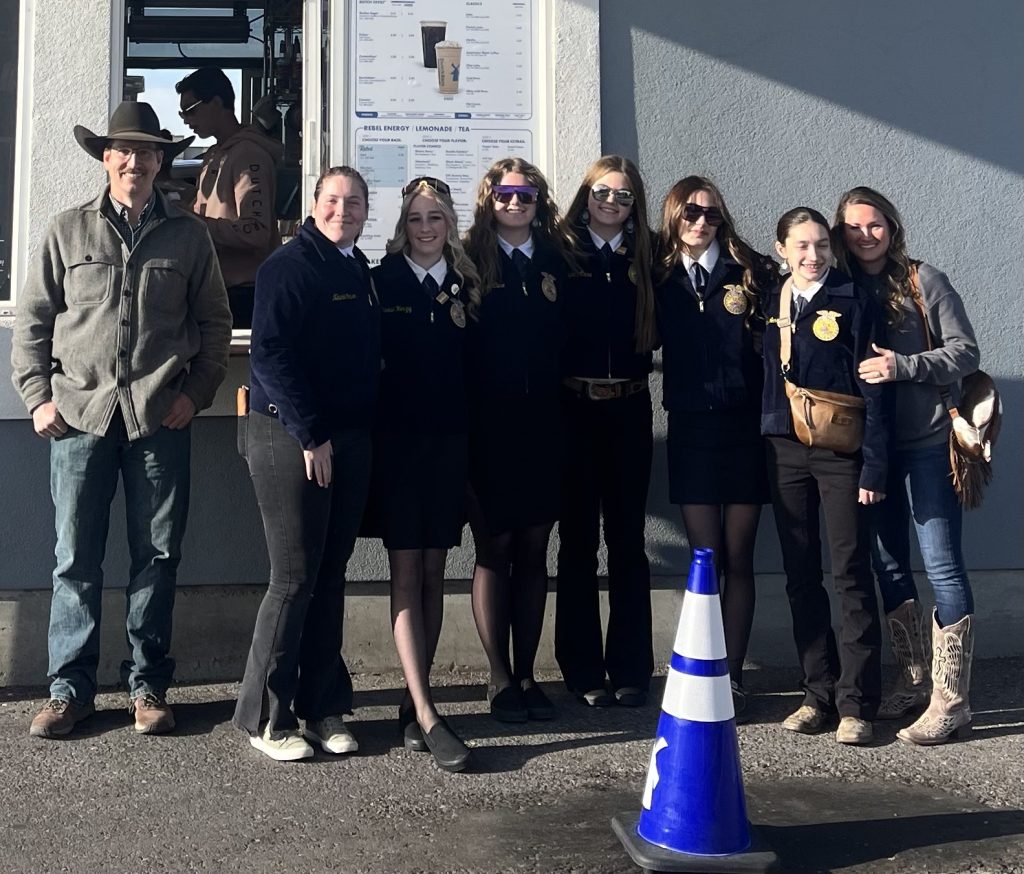
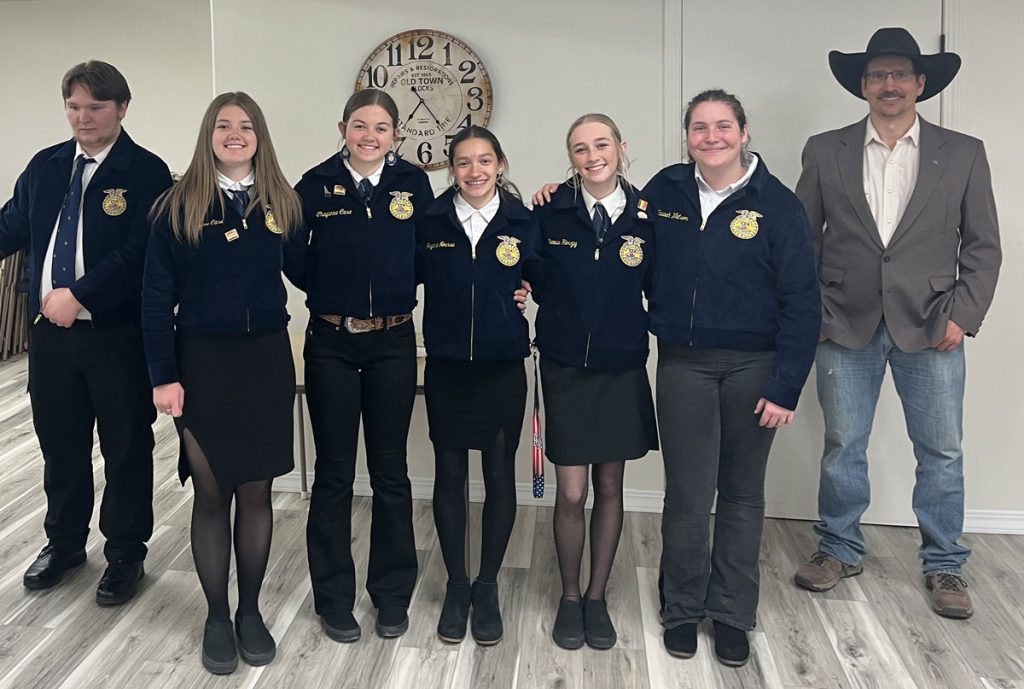
When James Boggan returned to Riggins in 2022, he thought he knew what to expect. The Salmon River High School graduate with a degree in rangeland ecology and management from the University of Idaho had worked for Agri Beef Co. and Simplot before stepping into the classroom. But teaching quickly proved to be a different kind of challenge and opportunity.
“I had to learn how to be a teacher and I really had no clue where to start,” said Boggan. “Going through the Inspire Ready program and First Camp helped me a lot. Having support from other educators around the state made a huge difference.”
His vision soon expanded beyond the classroom. With the support of the district, Boggan has added a greenhouse, doubled the number of welding booths and secured a new plasma table. He is also laying the groundwork for an aquaponics program.
“I thought I was just going to be in the classroom and in the shop,” said Boggan. “But opportunities kept opening up and we’ve been able to expand in ways I never expected.”
One of his biggest accomplishments was rechartering the Salmon River FFA chapter in 2023. What started with three students has grown to 10, all eager to take on Career and Leadership Development Events.
“It’s amazing how the FFA program helps students grow into leadership roles,” said Boggan. “I’ve seen them become more accountable, more confident and more driven.”
For Boggan, the impact of FFA is personal. As a student, he was part of the first chartering class in Riggins and credits those early experiences with shaping his own career. Now, he uses CDEs and LDEs not only as competitions but as curriculum guides, helping students tie classroom learning to real-world applications.
“Livestock evaluation has been the event students connect with the most,” said Boggan. “But now I have kids interested in public speaking, horse judging, forestry and parliamentary procedure. That’s exciting.”
He points to individual stories as proof of the program’s value.
“One student was a natural welder and always excited to take on new projects. He showed younger students what he made and now they’re all excited to be in shop class. He’s pursuing a degree in welding,” said Boggan. “Another student loved plant and animal science and took charge of our buck and bull scoring fundraiser. They even bought their own scoring kit and now measure elk and deer for people in the community.”
Looking ahead, Boggan has ambitious goals: strengthen welding and mechanics programs, expand the greenhouse, build aquaponics systems and take students to the FFA National Convention.
“One of our chapter goals is to go to Nationals in the next five years,” said Boggan. “The students are already working hard to make that happen.”
For Boggan, it all comes back to giving students opportunities that prepare them for the future—whether that’s in agriculture, leadership or life.
“I didn’t know if I would enjoy teaching when I started,” he said. “But seeing the look of surprise on a student’s face when they learn something new—that’s what makes it worth it.”
Graphic and Web Design program builds national reputation on real-world success
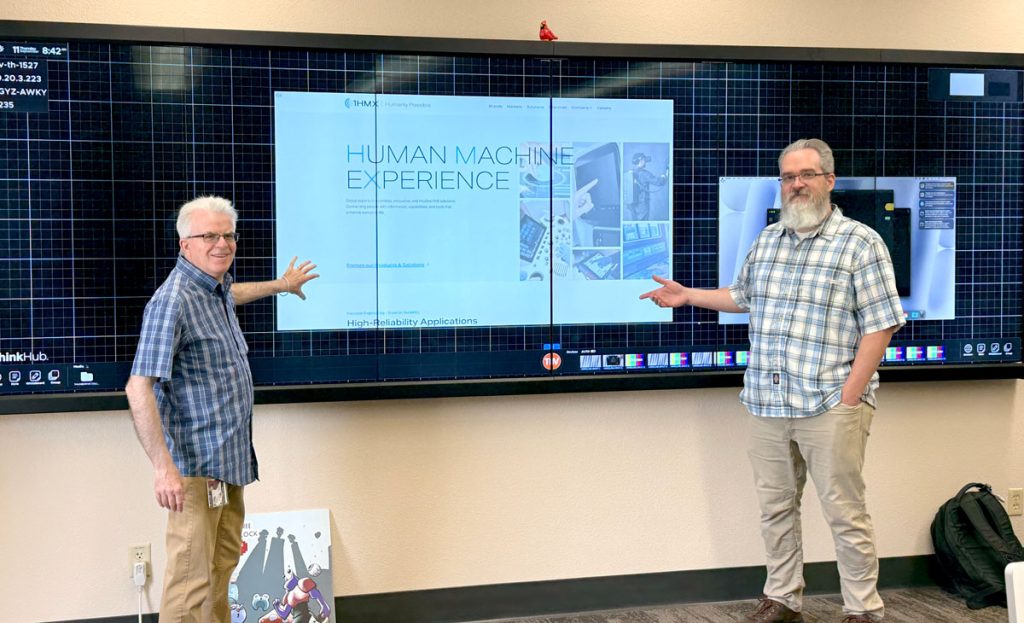
“Different years, different students, same results.”

That’s the unofficial motto of the Graphic and Web Design program at North Idaho College (NIC). Program Coordinator Philippe Valle has spent more than two decades making sure it holds up in the real world—and NIC students have the awards to prove it.
In 2025, they brought home Best of Show and multiple Gold, Silver and Cobalt awards at the Spokane American Advertising Awards (commonly known as the Addys)—the fifth time an NIC student has claimed the top prize. In 2024, students earned a Cobalt Award for web design. In 2023, they swept the Addys, with one student taking Best of Show plus Gold, Silver and Bronze medals while others collected regional and district honors that advanced to the national stage. Beyond the Addys, students have won the Printing Industry of America poster competition, designed logos and T-shirts for community organizations and even created a Pepsi semi-trailer wrap seen across the Northwest.
Two decades ago, when Valle first stepped in, the picture looked very different. He came to the United States in 1987 after beginning his design career in Europe . After working with Fortune 100 companies, he was asked to take over NIC’s then-struggling program in 2002. At the time, enrollment was just four students.
Today, the program functions like a two-year design agency that feeds talent to local employers and national brands. Students can earn a one-year certificate on the way to an advanced certificate or associate of applied science degree. Coursework covers Adobe applications, social media, UI/UX, video production, web development and portfolio building, with client projects and industry speakers integrated throughout.
“We teach practical and relevant skills to prepare our students for the ever-changing design industry,” Valle said.
Instructor and alumna Lydia Ramus, who worked in the field before returning to teach full time, said the format accelerates growth.
“There are so many opportunities for them,” Ramus said. “By the time they graduate, they’re ready to go out and do everything.” She added that courses are designed to build upon and support one another. “It’s constant reinforcement all around,” she said.
Funded through Gov. Brad Little’s Building Idaho 2.0 one-time grant, the program’s $500,000 lab expansion has transformed its footprint. The space now rivals—and in many cases surpasses—the technology in professional design agencies. Students work on iMac M4 workstations networked across the studio, experiment with 3D printing and packaging design and collaborate in front of a 14-foot interactive touchscreen wall that projects student work, allows real-time annotation and archives feedback for later review. They also train on a computer numerical control machine—industrial-grade equipment used to cut precision shapes from a variety of materials.
Valle said the facility was designed to feel like an agency rather than a classroom. Its central location on campus also gives the program visibility, often drawing in visitors who stop to ask about the work on display.
Those experiences lead directly to jobs. Valle cites a 95% placement rate, with many students landing internships or offers before graduation. Alumni now work at Adobe, Marvel, Carvana, Netflix Animation and high-end print firm Digital Lizard, as well as regional employers such as Buck Knives and Litehouse Foods.
“When you’ve worked in the industry for a long time, you know people,” Valle said. “We bring that network to our students.”
FCS teacher brings real-world skills to rural Idaho
At South Fremont High School, family and consumer sciences (FCS) teacher Kristy Hammond is proving that life skills aren’t “just electives.” They’re stepping stones to careers, confidence, and even small businesses.
“I never imagined I’d become an FCS teacher,” Hammond said. “But when the job opened, I realized all the jobs I’d worked in high school and throughout college—restaurant work, bookkeeping, preschool teaching, even baking for friends and family—actually taught me valuable skills. Each one gave me knowledge and experience that now makes me stronger in my role as an FCS teacher.”
Now in her fourth year teaching, Hammond leads two main career pathways: culinary arts and hospitality. Students begin with introductory food and nutrition courses, then advance to hands-on training. The capstone classes, she says, go far beyond textbooks.
“In our culinary capstone, students partner with Panera Bread in Idaho Falls,” Hammond explained. “They rotate through every station—taking orders, prepping food, even washing dishes. It’s the real deal, and the kids love it.”
Her program also partners with Texas Roadhouse, giving students field trip experiences that highlight customer service in a high-energy environment. Locally, Hammond works with a retirement home chef who calls her when job openings arise and often hires her students on the spot thanks to the food handler certifications earned in class.
One of Hammond’s proudest initiatives is Food Truck Wars, a capstone project where seniors design logos, set menus and run mock food trucks during finals.
“The teachers come in, sample everything, and vote for their favorite,” Hammond said. “It’s amazing to watch the kids apply every skill they’ve learned—cooking, budgeting, marketing—in one project.”
That entrepreneurial spirit carries into FCCLA, the national student organization tied to FCS programs. At South Fremont, Hammond’s students sell decorated sugar cookies for Christmas and Valentine’s Day, raising up to $1,600 each year.
“It started as a school fundraiser, but it grew into community orders,” Hammond said. “Parents wanted cookies delivered to their elementary school and junior high students. Teachers were making large orders for neighbor gifts. My culinary students were baking nonstop for weeks.”
For Hammond, the impact goes well beyond fundraising. One standout graduate took every class she offered, served as a state FCCLA officer, and went on to major in food science—eventually planning to help run her family’s beef jerky company.
“She told me she wasn’t really sure what she wanted to do in her life,” Hammond recalled. “But through our classes, she found her passion.”
Looking ahead, Hammond hopes to add interior design and eventually an early childhood education pathway. She also speaks directly to eighth graders about elective choices, making sure students know the career-technical options available.
“My goal is for students to understand that career technical education gives them real skills,” Hammond said. “Even if they don’t go to a four-year college, they can graduate ready to work, start a business or support themselves through school. That’s powerful.”
Persistence pays off for Idaho’s Adult Education Student of the Year
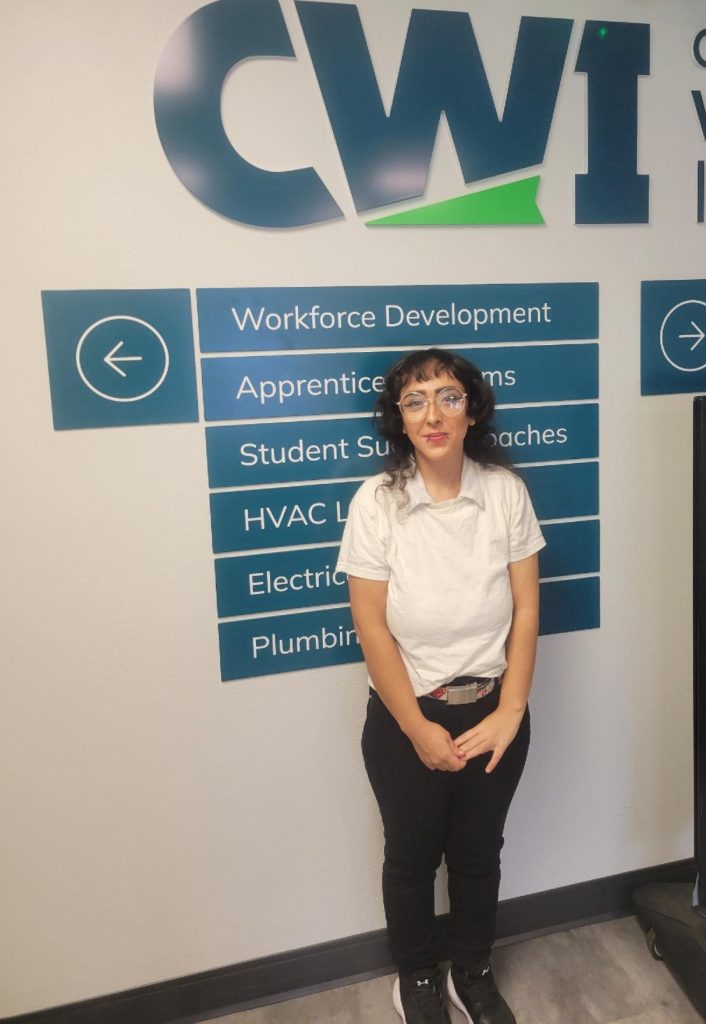
Each September, Adult Education and Family Literacy Week highlights the importance of programs that help adults build foundational skills, earn credentials and pursue higher education or career goals. The week also raises awareness of the barriers many adult learners face and the life-changing impact education can have on individuals, families and communities.
As part of this recognition, Idaho celebrates outstanding students and educators through the annual Adult Education Student and Teacher of the Year awards. Colleagues, supervisors and administrators from adult education programs across the state nominate individuals who exemplify persistence, growth and leadership. A review committee evaluates the nominations and selects the recipients.
This year’s Student of the Year is Alexandria “Ali” Horner, whose story of perseverance and achievement reflects the very spirit of adult education.
When Alexandria “Ali” Horner walked into her first adult education class, she carried more than textbooks. She carried the weight of anxiety, the sting of past bullying and the echoes of teachers who once told her she would never amount to anything.
Now, after more than 387 hours of dedicated study in a single year, Horner has proven those voices wrong. The Idaho Adult Education program has named her the 2025 Student of the Year, honoring her resilience, determination and academic progress.
“What motivated me the most was my therapist at the time encouraging me to go back for my mental health,” said Horner. “I also wanted it for myself. I had crippling anxiety, but working toward my GED opened up doors for me. I don’t really have anxiety anymore. I’ve learned to open up more, express myself and make friends.”
Alexandria “Ali” Horner

“I have really bad memory, so I applied myself a lot more. I just kept studying more and more until my English got so much better,” said Horner.
Transportation was another hurdle. Without reliable access to a car, Horner pieced together rides using buses, taxis and Ubers—whatever it took to get to class.
“That wasn’t gonna stop me, and it won’t,” she said. “I love going to class. It keeps me focused, and it helps my brain more.”
One teacher in particular made a lasting impact. Horner credits Tami Porter, an adult education teacher at the College of Western Idaho, who helped her break down complex reading and writing concepts. “She taught me how to understand big words, read properly and identify the narrator’s point of view,” said Horner. “She is a wonderful teacher.”
Porter, who was also named Idaho’s 2025 Adult Education Teacher of the Year, said watching Horner grow has been inspiring.
Horner’s journey hasn’t been easy. She lives with multiple disabilities including ADHD, autism and a language impairment. These challenges, especially with memory and focus, made schoolwork daunting. But rather than deterring her, they fueled her determination.
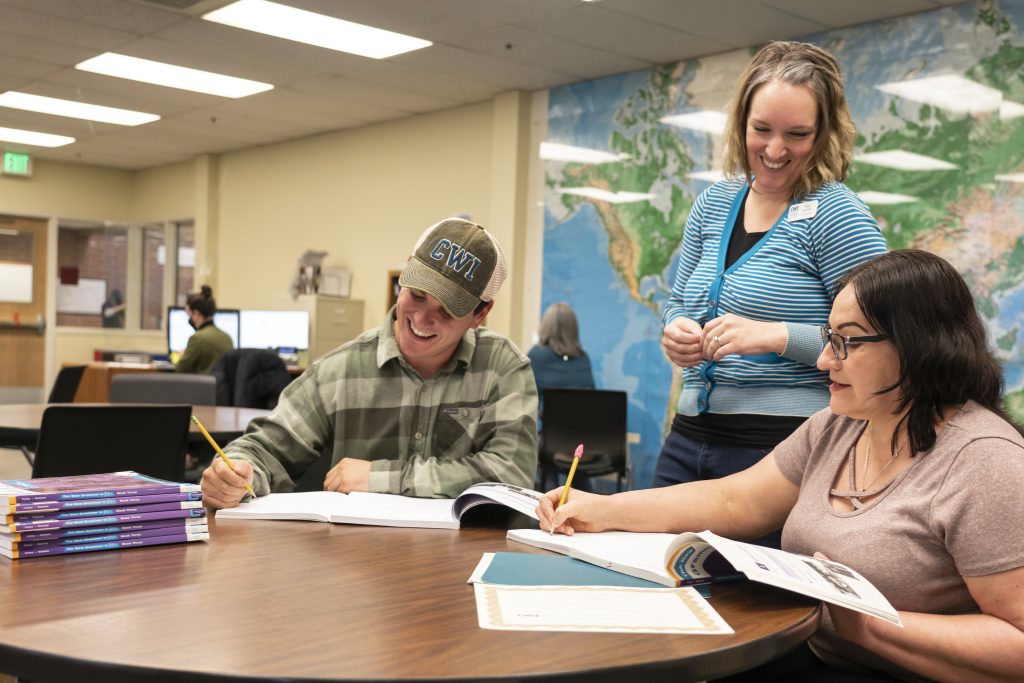
“Ali has shown determination and persistence by showing up to Reading and Language classes as well as studying in the Community Learning Center nearly every weekday. She isn’t afraid to ask questions and seek answers, which has helped her to find the right resources to help her improve her math and language skills,” said Porter. “I was thrilled when she came to me and asked to try the more challenging class, showing me that she has gained confidence in herself and in her reading. She has been a great example to the students around her by showing them that you can succeed through hard work.”
When the workload felt overwhelming, Horner leaned on her mother, mother-in-law and boyfriend. Her mother, she said, was especially instrumental.
“My mom has always had a hard life, and she didn’t want that life for me. She encouraged me, bought my GED books and even paid for my rides,” said Horner. “If it wasn’t for her, I don’t think I would have kept going.”
Her boyfriend also played a big role. “He woke up extremely early every day to take me to the bus or drop me off when I didn’t have a ride. He’s my better half,” said Horner.
Horner also found family in the Community Learning Center. Staff members like Shani Cummins, Vicki Flowers, and David Wheeler made a huge impact on her journey. “Most of the staff at the CLC became a second family to me,” she said.
Along the way, Horner also discovered tools that worked for her, like Khan Academy’s online lessons. She also relied on music to stay calm and focused during class. “International music and learning new languages helps a lot with intellectual and cognitive disabilities; it keeps me focused and helps me not have my ticks in class,” Horner explained. She also finds inspiration in artists like Skitz Kraven, a horrorcore musician who speaks openly about mental health struggles, including paranoid schizophrenia, OCD, and bipolar depression.
Leading with Compassion: Kara Mahannah shapes Idaho’s Oldest CAAHEP-accredited medical assisting program


When Kara Mahannah stepped into the role of program manager at the College of Southern Idaho’s Medical Assisting Program in 2009, she knew she was inheriting a legacy. Now, as the program prepares to admit its 35th cohort, Mahannah continues to drive innovation and inspire the next generation of healthcare professionals.
Medical assistants play a crucial role in outpatient healthcare settings. They are trained to perform both administrative and clinical tasks—everything from scheduling appointments and managing patient records to taking vital signs, assisting with exams, drawing blood and educating patients.
“We train students for a wide range of roles in clinics—from front desk operations to assisting with procedures in family practice, pediatrics, urgent care and specialty settings,” said Mahannah.

Her own journey in healthcare began with a nursing degree from CSI in 1996. “I graduated from the practical nursing program at CSI in 1996,” said Mahannah. “I worked in a hospital and outpatient clinics before joining CSI, and I’ve always loved being part of a team that takes care of others.”
Her connection to CSI began even before her employment, coordinating student clinical rotations at her former clinic. That hands-on experience, combined with her nursing background, positioned her perfectly to lead the state’s longest-standing Commission on Accreditation of Allied Health Education Programs-accredited medical assisting program.
Mahannah has overseen major changes, including adapting the program structure to better serve non-traditional students.
“We adjusted the hours from five days a week to two and a half,” said Mahannah. “That flexibility really helps students who are balancing school with work and family.”
She’s also pushed for technological advancements, replacing heavy textbooks with digital resources and integrating electronic health record systems into the curriculum.
“Everything is accessible from day one,” she said. “And students get real-world practice using tools they’ll encounter on the job.”
The program’s five-year job placement rate of nearly 88 percent and a national credentialing exam pass rate of 91.3 percent speak to its quality. Mahannah credits much of that success to her technical advisory committee, a diverse group of over 30 stakeholders from the community, clinics, education and CSI administration.
I’m constantly reaching out to employers, asking how we can work together,” said Mahannah. “We hold lunch-and-learns, attend health fairs, and ensure our curriculum aligns with industry needs.
Kara Mahannah
But for Mahannah, the heart of her work lies in student transformation. She recalled a woman who joined the program after caring for her terminally ill husband.
“She called and said, ‘I think I’m too old to do this,’” said Mahannah. “But she worked so hard, commuting from Glenns Ferry on a tight budget—and this was before we changed from five days a week to two and a half. I’ll never forget the moment when she walked across that graduation stage, with her kids and grandkids cheering.”
Another student with a physical condition that didn’t allow her to meet some of the physical demands of the clinical track, but Mahannah helped her pivot to an administrative path. “She stayed in the program and is now working in a medical office,” she said. “We found a place where she could thrive.”
Mahannah emphasizes skills beyond the technical, like empathy, communication, and professionalism.
“Human interaction isn’t going away in healthcare,” she said. “Medical assistants are often the ones patients talk to most.”
Looking ahead, Mahannah wants to continue offering a thriving, high-quality program that produced competent medical professionals in an affordable setting.
“I want students to feel like they’re part of a professional team that cares for others,” said Mahannah. “This isn’t just a job—it’s a calling.”
Culinary teacher uses SkillStack® to engage students and build workforce-readiness skills


Brooke Scoville, a culinary instructor at Renaissance High School, combines her years of experience as a pastry chef and catering business owner with a passion for teaching practical skills that directly benefit students in the workforce. She has incorporated SkillStack® into her classroom since 2018, and in 2024, she introduced a new way for students to access their SkillStack information and enhance their ability to build industry-relevant skills.
SkillStack® is a microcredential platform used by Idaho educators to validate student proficiency in key skills. The platform awards digital badges representing competencies learned through rigorous training and assessments. These badges not only serve as motivation but also help employers identify qualified candidates, enhancing the employability of SkillStack® participants.
The platform uses the Open Badges standard, allowing learners to share their achievements across platforms. This makes it easier for employers to view the badges, understand the skills associated with them, and verify when and how the badge was earned. While students can use the badges to earn postsecondary credit, Scoville notes that employers have yet to fully adopt them. However, there are ongoing efforts to raise awareness about the value of SkillStack® badges to employers, helping them recognize the qualified candidates who have earned these industry-relevant credentials.
It gave them a fun, real-time way to track their progress, and they loved seeing their achievements grow.
Brooke Scoville
In Scoville’s hands-on culinary classroom, students learn in a kitchen, so they don’t have access to computers or laptops to track badges online. Instead, each student has their own personal chart where they place stickers as they earn badges.
“It gave them a fun, real-time way to track their progress, and they loved seeing their achievements grow,” said Scoville.
The charts became a central classroom feature, motivating students and inspiring younger ones to envision earning the badges.
“The great thing about having the badges on the wall is that younger students get to see the advanced students’ progress, which helps them understand what they could achieve,” said Scoville.
Scoville emphasizes that the badges represent meaningful skills students will carry into their careers. This approach reinforces that the badges represent real, employable skills.
“It’s about demonstrating competency, not just ticking off a list,” she explained.
The classroom culture encourages students to learn from mistakes rather than penalizing them. If students make errors, they can learn from them and master the skills needed to earn the badges.
Incorporating SkillStack® has greatly boosted student engagement. Earning SkillStack® badges is also a key requirement for the Workforce Readiness and Career Technical Education diploma. To earn this diploma, students must complete graduation requirements, finish a CTE pathway, pass a Technical Skills Assessment and Workplace Readiness Assessment, and demonstrate competency through SkillStack® badges or industry certifications. Local education agencies are encouraged to recognize students who earn the diploma. In the West Ada School District, where Scoville teaches, students who achieve the designation were recognized last year with a special cord at graduation.
“Since we introduced the CTE diploma, students are more motivated to come to class regularly and put in the work,” said Scoville. “It’s not about letter grades anymore; it’s about demonstrating real-world skills.”
At the end of the year, students will be recognized for their achievements in a special ceremony, where their SkillStack® charts will be displayed. This recognition, paired with the skills they’ve mastered, provides a strong incentive for continued dedication.
“Seeing their progress in such a tangible way has really made a difference,” said Scoville.
Fire academy training proves vital in real-world emergency response
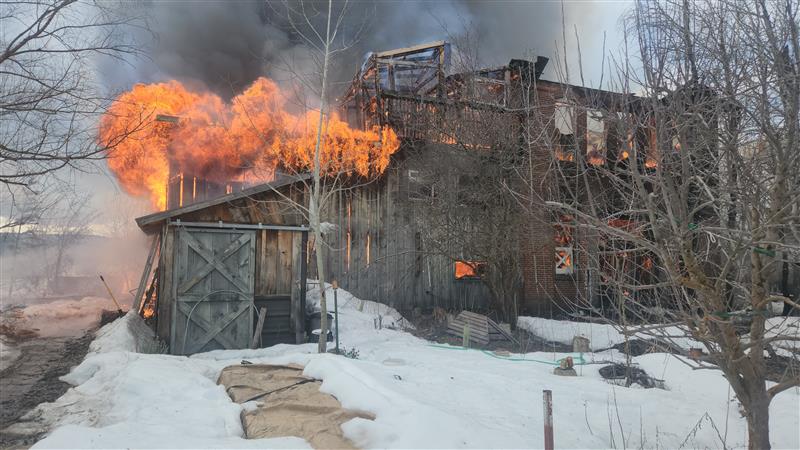

New Meadows, Idaho — On March 24, Fire Service Training (FST) Program Director Brad Terry found himself in the right place at the right time while driving back from the Clearwater Fire Academy in Orofino. As he passed through New Meadows, he noticed smoke rising from the valley and quickly turned around after seeing a Meadows volunteer fire truck heading in the opposite direction.
“As I got closer, I could tell this was a bigger fire, likely a structure fire,” said Terry.
By the time he arrived, the two-story brick building was fully engulfed, with the roof collapsing. Terry offered assistance, helping set up water supply lines for the local responders and learned that two of the firefighters battling the blaze had just completed their training at the Clearwater Fire Academy that weekend. One of the volunteer firefighters had taken the Fire Essentials course days earlier.
“He looked at me and said, ‘Hey, weren’t you at Clearwater?’” said Terry. “I said, ‘Yeah, you were too!’ It was amazing to see someone apply what they had just learned in such a real, immediate way.”
“It’s incredible to see how the training is paying off right away,” said Terry. “These volunteers are really committed to their communities, and this training gives them the skills to respond when they’re needed most.”
Brad Terry
Terry also met a Fish and Game officer volunteering with the Meadows Valley Fire Department who had taken the same course.
“It’s incredible to see how the training is paying off right away,” said Terry. “These volunteers are really committed to their communities, and this training gives them the skills to respond when they’re needed most.”
FST offers courses ranging from basic fire essentials to advanced certifications in areas like hazardous materials and rescue operations. After completing training, firefighters can take exams to become certified in specific firefighting skills. These certifications help ensure that both volunteer and professional firefighters are prepared for emergencies.
The Clearwater Fire Academy is one of several FST events held each year, drawing hundreds of participants to gain certifications or renew existing ones. This past weekend’s academy saw 230 attendees who received hands-on training in fire suppression, rescue operations, and hazardous materials management.
“Training isn’t mandatory in Idaho, but it’s strongly recommended,” said Terry. “Having certified firefighters on the frontlines means a more effective response and can even lower insurance ratings for the community.”
The true value of the training was evident during the New Meadows fire.
“In this job, you never know when you’ll be tested,” said Terry. “Seeing these firefighters apply their skills from Clearwater to this fire shows just how important this training is.”
CWI’s Mindy Young leads students to success in network and system administration
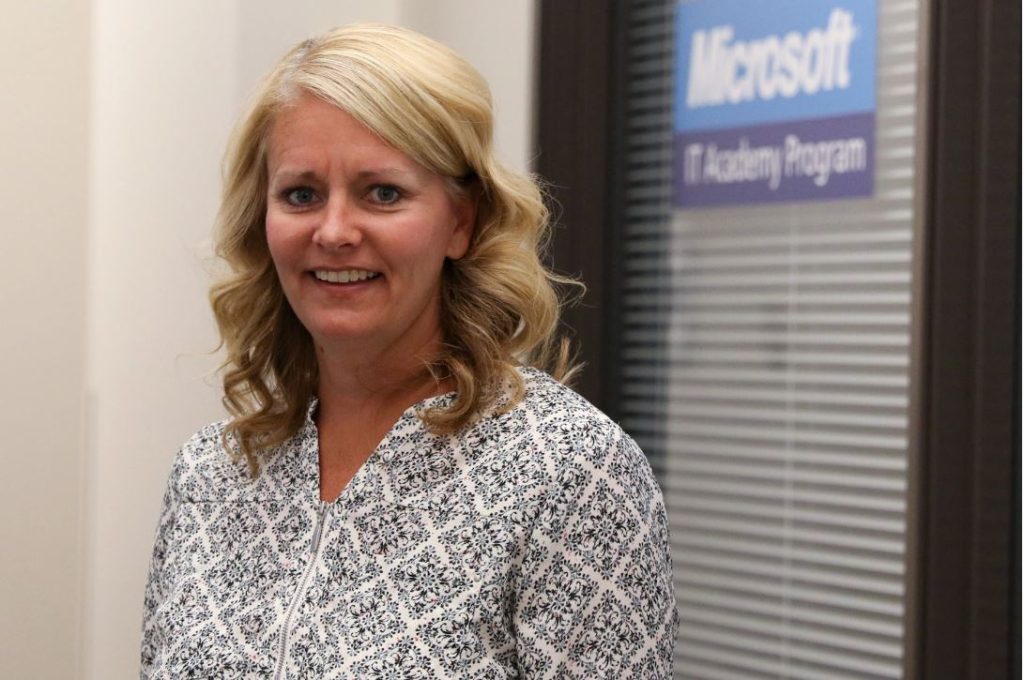
Mindy Young, a dedicated educator at College of Western Idaho (CWI), has spent the past 15 years guiding students toward successful careers in network and system administration. Her journey into education began after a successful career in healthcare IT. After earning her degree from Utah State University, Young worked in IT for Intermountain Healthcare for nearly a decade as a system administrator.
“I was excited to land my first system administrator job, but when the program I was working on was shut down, I decided to step back and get into education,” said Young.
With two young children at the time, Young sought a career change that would allow her to be more present at home. She obtained her Microsoft Certified Trainer (MCT) certification and began teaching for local IT education companies before moving to Boise. Before long, a friend suggested she look into teaching at Boise State University’s Selland College of Technology. When CWI opened its doors in 2009, Young joined the institution as one of its founding faculty members. Her move to CWI allowed her to further her passion for education and contribute to shaping the college’s emerging IT program.
The goal of the program is to get students jobs in the industry, starting with roles like help desk support and moving up to system administration.
Mindy Young
The program spans four semesters and leads to an Associate of Applied Science degree in Network and System Administration. Students can also earn industry technical certificates along the way, including certificates in Networking, Security, Database Fundamentals and Cloud Infrastructure. This structured pathway helps students gain foundational skills before advancing to more complex areas of IT.
Young continually evolves her curriculum to reflect the rapidly changing tech landscape, incorporating cloud-based systems alongside traditional on-premises servers.
“I’m an active member in the MCT community, and I attend conferences like the MCT Summit to stay in touch with my peers and learn about emerging technologies,” said Young.
This dedication to professional development allows her to offer a curriculum that’s both relevant and hands-on. Her classes are designed to balance lecture with practical experience, and many of her graduates have gone on to land high-level positions in IT, including cloud architects and system administrators. But Young was recently reminded of her impact when a former student came to her aid during an IT issue at CWI.
“Just a couple of months ago, we lost internet connectivity in our classrooms, and I called the help desk. On the other end was one of my graduates,” said Young. “When he told me his name, I realized it was one of my former students. It was so rewarding to see him now providing support in the very field he trained for, helping to solve a problem at CWI.”
Young’s impact extends beyond the classroom.
“Employers are reaching out to me because they know my students come out of the program with solid skills,” said Young. “Many former students are now in hiring roles themselves, contributing to the ongoing success of the program.”
Balancing a demanding workload can be challenging, but Young finds the work incredibly rewarding.
“I do it because I know I’m making a difference. It’s fulfilling to see my students succeed and change their lives,” said Young.
Looking ahead, she’s excited about upcoming changes to her program, including a shift toward cloud security and the program’s name change to Cloud Security and System Administration next fall.
“We’re adapting to prepare our students for a hybrid IT world, with both on-prem and cloud-based systems,” said Young. “I’m optimistic these changes will attract even more students to the field.”
Health professions programs bridge community and career


Kay Gardner spent three decades at the Pocatello Children’s Clinic, taking on various roles in billing, collections and reception. Though she loved working in healthcare, she knew she didn’t want to remain in clerical work until retirement. What she didn’t know was that her husband, Mike, would be the key to helping her discover her calling.
“Mike was a paramedic who often taught night classes at local colleges, so he was gone all the time. I said, ‘You know, I really don’t like staying home alone, so I’m going to take an emergency medical technician (EMT) class so I can teach with you,’” Gardner recalled. “I took the class, and as part of it, you get to run on the ambulance, and it just stirred my soul.”
After taking the EMT class, Gardner continued her work at the clinic and served in the reserves at the Blackfoot Fire Department. In 2019, an opportunity aligned her career with her newfound passion. When her husband retired, an acquaintance contacted him about taking over her EMT class at Idaho Falls School District No. 91’s Career and Technical Education Center. Eager for a new direction, Gardner jumped at the chance.
“I suggested I take the position and haven’t looked back,” said Gardner.
Gardner used her experience and connections as an EMT to reimagine the year-long program, which includes dual credit through CSI. Classes run for two hours a day, four days a week. The extensive curriculum incorporates allied health, medical terminology and optional modules such as blood glucose monitoring and IV training. The CMA program is also a year-long program. Although students are technically supposed to receive an hour of CMA instruction each day, there’s considerable overlap between the programs.
I took the class, and as part of it, you get to run on the ambulance, and it just stirred my soul.
Kay Gardner, CMA and EMT instructor
“EMTs and CMAs both need to know medical terminology and allied health. They all earn their Assist with Medications, CPR, OSHA and Stop the Bleed Certifications. I just figure the more they know the better prepared they are for the world,” said Gardner. “In addition to clinical skills, CMAs also need to have clerical skills, so that’s the main difference.”
Gardner’s connections have led to a strong technical advisory committee (TAC) that supports her programs by donating equipment and providing guidance on skills and equipment students need. In addition to providing internships and hands-on experience, TAC members also volunteer in the classroom.
“I can’t do skills training with this many kids and have them be safe, so I have people who do this for a job come in to help teach and test,” Gardner explains. “Bonneville County Fire members were here practically as much as I was last year.”
This collaborative effort fosters a sense of community among the emergency medical services (EMS) in Southeast Idaho, with active participation from Central Fire Department in Rigby, Bonneville County Fire District in Idaho Falls, Idaho Falls Fire Department and Ammon Fire Department.
Upon completion of the program, students are prepared to take the National Registry of Emergency Medical Technicians exam.
“Some of my students go straight into industry as EMTs, and most of them go on to do fire services as well,” said Gardner. “I try to make sure that even if EMS isn’t their pathway, they learn something that will help them in their career.”
SkillStack® sees 34% increase in badges issued

The SkillStack® microcredentialing program saw a 34% increase in the number of badges issued between the 2022-2023 and 2023-2024 school years. This growth follows the introduction of the Workforce Readiness and Career Technical Education Diploma in 2021, along with the expanded use of microcredentials in academic and CTE programs at the postsecondary level.
Launched during the 2015-2016 school year as part of Idaho’s effort to enhance workforce readiness, SkillStack® provides students with targeted microcredentials that align with industry needs. The program aims to equip learners with essential skills necessary for today’s job market. Each microcredential represents skills gained through rigorous training and assessment. This clarity allows employers to identify qualified candidates more easily, enhancing the employability of SkillStack® participants. With Board policy changes that went into effect during the 2023-2024 school year, postsecondary institutions can also award prior learning credit for stacked microcredentials.
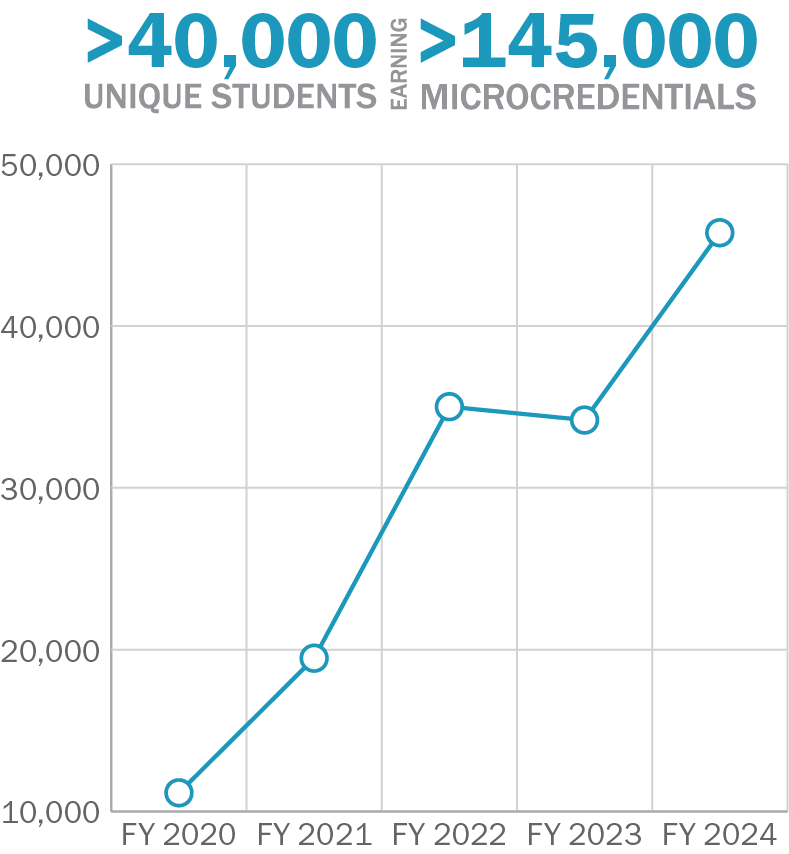
The SkillStack® program uses the Open Badges standard, the world’s leading format for digital badges, allowing learners to share their achievements across multiple platforms. This interoperability enhances learner mobility and supports their ability to present skills to potential employers, who can identify who issued the badge, when and where it was earned and what criteria were used to earn it.
SkillStack® has quickly become an integral part of Idaho’s educational landscape. It bridges the gap between traditional education and the skills required by employers. By offering credentials that reflect specific competencies, SkillStack® prepares students for immediate entry into the workforce.
Due to its commitment to maintaining high standards, Idaho was one of 20 vendors and educational institutions invited to join the TrustEd Microcredential Coalition from 1EdTech, a global nonprofit community focused on improving the digital learning ecosystem for all learners. This coalition includes leaders from higher education, educational technology suppliers, and K-12 districts. Additionally, representatives from Idaho have been invited to speak at several national conferences and webinars to share best practices.
“With the rise in demand for microcredentials, transparency and quality digital credentials are essential,” said Heather Luchte, IDCTE’s chief performance and accountability officer.
Engagement with local businesses is a critical component of SkillStack’s® strategy. By collaborating with industry partners, the program regularly updates its offerings to reflect current workforce needs. This partnership benefits students and provides employers with a steady pipeline of skilled talent.
To remain at the forefront of workforce readiness, IDCTE accepted nominations for its new Idaho Microcredential Advisory Council, which will focus on developing best practices and building support for microcredentials and digital badging. Representatives from secondary and postsecondary institutions, industry partners, and employers across the state were invited to serve on the council.
“SkillStack’s® growth and recognition reflect the ongoing shift towards skills-based hiring,” said Luchte. “By focusing on microcredentials, the program enhances the employability of its participants and prepares them for the challenges of a rapidly changing job market.”
 Official Government Website
Official Government Website